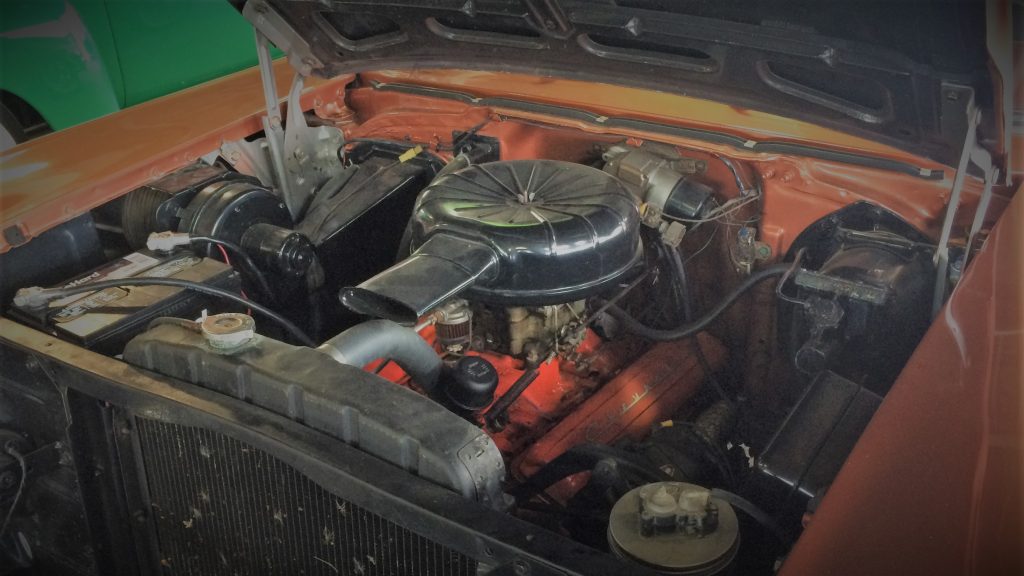2015 is the 60th anniversary of the small block Chevy engine.
We’re keeping the Mouse Party celebration going by counting down Chevy’s five best factory small blocks ever. Spanning six decades and five generations of motors, we had plenty of candidates to choose from as the small Chevy (particularly the Gen I) is one of most ubiquitous engines ever produced. We looked at everything from the 262 (then quickly turned away) to the massive LS7 to compile our list of five.
Lists are fun. Lists create conversation–and sometimes even heated debate. So we invite you to share your own Top 5 in the comments section below. Our complete Top 5 will be unveiled over the next couple of weeks, starting with #5…

The Original Mouse
Our list starts where the small block started–with the 265 Turbo-Fire.
This is the engine that started the small block revolution in 1955. It laid the foundation for all the small block engines that would come after it. Using the same fundamental 90-degree design and 4.4-inch bore spacing of the 265, Chevrolet engineers later added new bore sizes and piston strokes to create an entire family of small blocks. And this family of small blocks changed the entire face of hot rodding thanks to the availability, affordability, and interchangeability of related performance parts.
When it was introduced in the 1955 Chevrolet Corvette and Bel Air models, the 265 delivered nearly twice the horsepower of the venerable Ford Flathead motor, yet weighed less than Chevrolet’s six-cylinder mills. You could get the 265 engine in three flavors by 1956: single 4-barrel carb, twin four-barrel carbs, or twin four-barrel carbs with high lift cam. The latter option bumped output up to 240 horsepower.
It wasn’t until 1957 that Chevrolet achieved the coveted one horsepower/cubic inch output with its 283 Turbo-Fire Ramjet (mechanical fuel injection). However, this engine used the stock 265 block bored out to 3.875 inches to hit the mark so the 265 gets partial credit for the achievement.
The 265 is also credited by many for saving another Chevrolet legend: the Corvette. With Corvette sales slumping, the 265 was developed quickly by chief engineer Ed Cole as an upgrade to the Corvette’s underpowered 235 I6 motor. The added power output of the 265 V8 helped revive sales numbers and the Corvette, as you may have heard, lives on today.
For historical purposes, the original Chevy 265 makes our list of Top 5 small blocks ever.
Associated Vehicles
1955-57 Chevrolet Bel Air
1955-57 Chevrolet Corvette
Specifications
1955 – 1957 with 2 Barrel Carb
Horsepower: 162 @ 4,400 rpm
Torque: 257 ft.-lbs. @ 2,200 rpm
Stroke: 3.00
Bore: 3.75
Compression: 8.0
1955 with 4 Barrel Carb
Horsepower:180 @ 4,600 rpm
Torque: 260 ft.-lbs. @ 2,800 rpm
Stroke: 3.00
Bore: 3.75
Compression: 8.0
1955 with 4 Barrel Carb (Corvette Model)
Horsepower: 195 @ 5,000 rpm
Torque: 260 ft.-lbs @ 3,000 rpm
Stroke: 3.00
Bore: 3.75
Compression: 8.0
1956 with 2 Barrel Carb (Automatic)
Horsepower: 170 @ 4,400 rpm
Torque: 257 ft.-lbs. @ 2,400 rpm
Stroke: 3.00
Bore: 3.75
Compression: 8.0
1956 with 4 Barrel Carb
Horsepower: 205 @ 4,600 rpm
Torque: 268 ft.-lbs. @ 3,000 rpm
Stroke: 3.00
Bore: 3.75
Compression: 9.25
1956 with 2 X 4 Barrel Carbs
Horsepower: 225 @ 5,200 rpm
Torque: 270 ft.-lbs. @ 3,600 rpm
Stroke: 3.00
Bore: 3.75
Compression: 9.25
1956 with 4 Barrel Carb (Corvette Model)
Horsepower: 210 @ 5,200 rpm
Torque: 270 ft.-lbs. @ 3,200 rpm
Stroke: 3.00
Bore: 3.75
Compression: 9.25
1956 with 2 X 4 Barrel Carbs (Corvette Model)
Horsepower: 225 @ 5,200 rpm
Torque: 270 ft.-lbs. @ 3,600 rpm
Stroke: 3.00
Bore: 3.75
Compression: 9.25

I’m 71 yrs. old and lived it. They (small block) were the greatest, need I say more.
My all time fav is the 1969 Z28 302. I have been told it was actually closer to 301cid. The SBC has been at the centre of my motorhead life for 50yrs.
I think the 406 was the baddest in the pre- LT, LS era. Of course you had to build your own.
I would agree w/ S. Lawrence as the 1969 “DZ” engine as the #1. I owned one and wish I had NEVER sold it.
Did Chevy make a 302 4 bolt main and a 305 4 bolt main
I had a 1957 with a 265- 2bb carb. It was a smooth running powerhouse.
To me the 350 LT1 was the best small block
engine with 360 HP in the Camaro and 370 HP
On the Corvette